Gluten Free Easy, Easy, Easy! French Bread Recipe
Updated Oct 17, 2025, Published Nov 11, 2011
This post contains affiliate links. Please see our disclosure policy.
Today is supposed to be a very lucky day – 11/11/11. And personally, I am inclined to believe it. It was lucky for me and I think lucky for you. I had a gluten free bread baking recipe breakthrough.
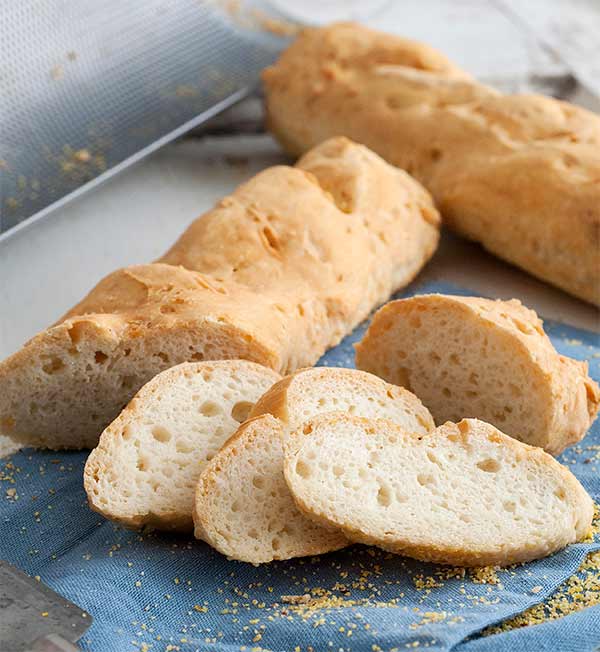
Table of Contents
As a person who spends most of her time creating gluten free recipes you can imagine that I get my fair share of emails asking if I have a really good recipe for gluten free bread. Before going gluten free I made a few loaves of bread (with varying degrees of success) but I was by no means a bread baker. When I get these emails I think “Why ask me? Why not ask a bread baking expert?”
But the more I thought about it, the more I realized, I am probably the perfect person to ask. Why? Because:
1. I went for probably 15 years without eating bread so I know I can live without it – I would rather not eat bread than eat yucky, grainy, crumbly bread.
2. I love great food but I am also kind of lazy so I am always looking for the easiest way to make something.
3. I am not a person who finds it “relaxing” to knead dough by hand for 15 minutes. I wish I was that kind of person, but sadly when I do menial tasks for any period of time, my mind starts to wander and that is never a good thing!
4. I am success driven, persistent and some might even say a little OCD – I will keep at something until I get it right.
So, I decided to put my mind to making great gluten free breads. I decided to start with gluten free French Bread. I did my homework, I studied first the traditional French Bread recipes and methods, then I looked at gluten free ingredients and studied how to make them work better and finally, I baked and baked and baked!
I played around with flours and baking times and methods until I got a gluten free French Bread recipe that was crunchy on the outside, tender on the inside, beautifully browned, tastes like what French Bread should taste like and was easy to make. I threw away a lot of bread, enlisted everyone I came across (including a good number of whom are regular gluten-eaters) in blind taste testing and finally, I am pleased to say, came up with a recipe I am happy with! And I think YOU will love!
And you want to hear the very best thing? It is actually EASIER to make gluten free French Bread than it is to make the gluten-filled kind! Yes, you heard right – EASIER! No kneading, no double rising (I tried, better without) no hours until bread is ready. You can actually have lovely, perfect gluten free French Bread in about an hour and a half, start to finish!
Ok… so here are some tips I discovered:
Equipment
You are going to need a mixer – it is going to do pretty much all the work for you. You also need a French bread pan – gluten free bread needs support when it is rising and baking. Fortunately, you can get one for under $20.00 – considering the cost of decent gluten free bread, an investment so worth it! The pans come either perforated or solid, I used both in testing and it didn’t make a huge difference but I did like the results from the perforated pans slightly more. And finally, unless you are dead certain your oven is totally accurate, run over to the hardware or grocery store and grab an oven thermometer for about 4 bucks – you should have one anyway!
Kneading
Remember when the internet was all abuzz about no-knead bread? Ha! That’s old news to us gluten free bakers! 3 minutes in the mixer and that’s pretty much it, no kneading what-so-ever!
Yeast
I got the best result from Dry Active Yeast. It needs to be “active” so if you have had a jar sitting in your fridge since you can’t remember when, go get a new one – it lasts about 6 months refrigerated, after that it may not be good any longer. If you do store your yeast in the fridge then it will take longer for the yeast to “proof.” You want the yeast mixture to pretty much double in size and be all foamy.
Flours
After testing all sorts of different flour combinations, what worked best was a simple combo of white rice flour, sweet rice flour (also called glutinous flour) and tapioca starch. I used all Asian flours (Erawan Brand) which are more finely milled and cost a fraction of the flours you get in the health food store. I also tested this recipe using my own flour and it came out really great (well…dahaaa!) and the dough was a tad easier to work with.
Gum and Fat
I found that mixing the xanthan gum with the fat (olive oil) before adding it to the batter made it work better. I wish I could tell you why, just trust me on this.
Prep
Get all your ingredients out, mix your yeast, blend the xanthan gum with the oil and lightly beat your eggs before you start to mix, it makes it easier. Do the steps in order as I give you in the recipe.
The Dough
If you were used to bread making in a former pre-gluten-free life you will think there is not enough flour in the dough because it has a consistency more like a thick batter than dough. Resist with every fiber of your being from adding more flour! This is just the way gluten free bread dough is. You need to spoon the dough into the pans and shape it with a spatula – it won’t magically turn into pretty ovals unless you do this.
Slashing the Dough
Cutting 3 or 4 diagonal slashes into the top of the dough will help the steam escape while it is baking giving you a lovely, tender texture.
Prepping the Pans
Either spray your French Bread pans with gluten-free, non-stick cooking spray or brush with oil before putting the dough into the pans to rise. For a really authentic bottom, sprinkle a teaspoon of cornmeal on the bottom of the pans after you oil them up. It isn’t completely necessary but it does add that certain je ne se qua (fancy French term for “a certain something”). If using the perforated pans, place them on top of a baking sheet to oil and dust with cornmeal or you will have a mess to clean. Do not bake the bread on the baking sheet however, just put the French bread pan right on the oven rack.
Browning
I tested everything I could think of to get the perfect brown on the French Bread and what I found gave the best color came from brushing the loaves with melted butter just before baking. The good news is that they also came out beautifully browned with a brushing of melted Earth Balance as well – keeping the bread totally dairy free if need be.
Humidity
To get that crunchy crust and tender inside so characteristic of good French Bread it should bake in a humid environment. This is easily created by putting a pan of hot water into the oven while it preheats and just leaving it there while the bread is baking. You can also spritz the oven occasionally with water from a spray bottle but then you have to remember to do it whereas the pan of water just sits there and does its job.
Here’s how the whole thing goes:
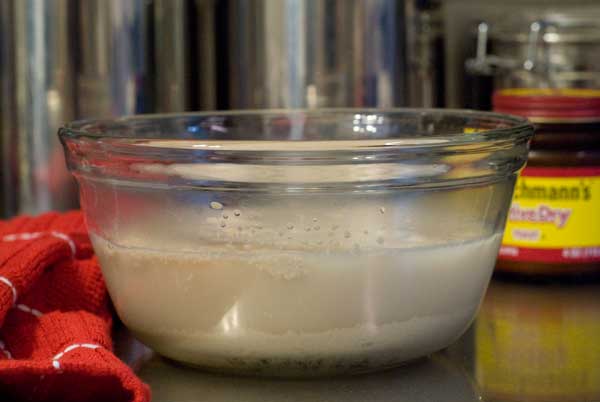
Mix the yeast, sugar and warm water – whisk to dissolve.
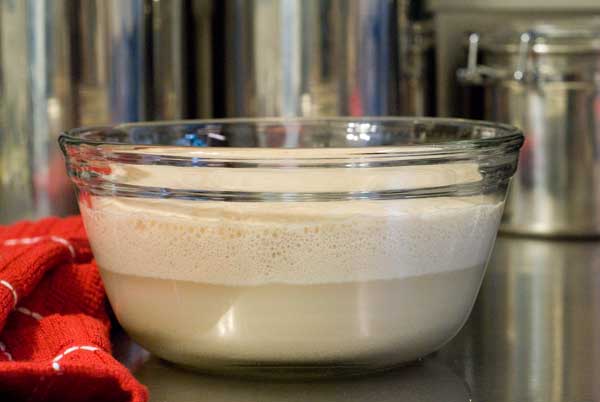
Let the yeast “proof” until foamy and doubled in volume.
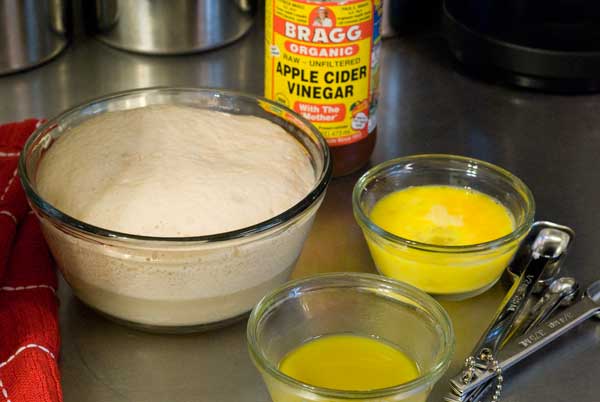
Get all your ingredients ready before mixing.
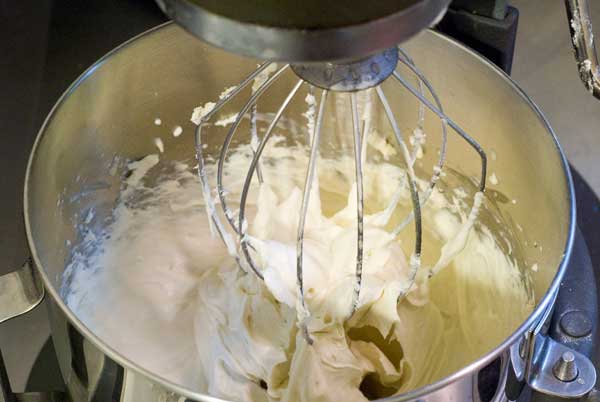
The dough will look more like batter than dough.
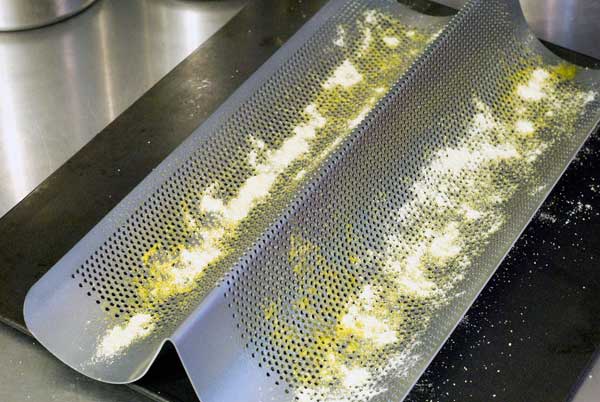
Grease the pan with oil and sprinkle with some cornmeal.
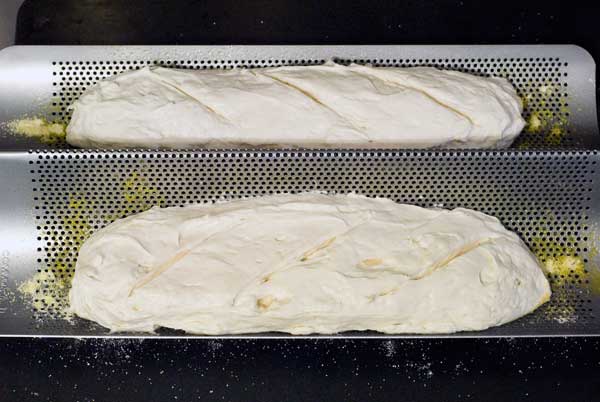
Spoon batter into pans, shape into ovals and slash the top 3 or 4 times.
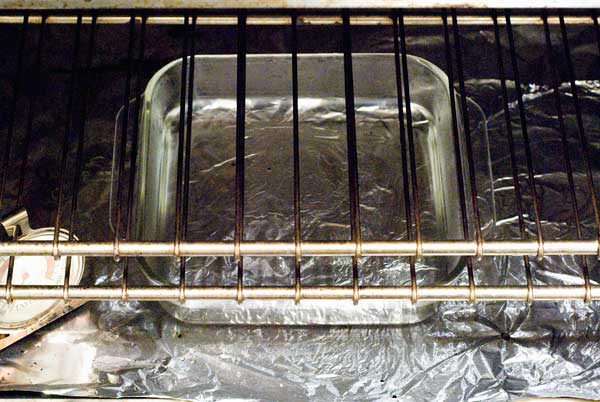
Place a pan of hot water into the bottom of oven.
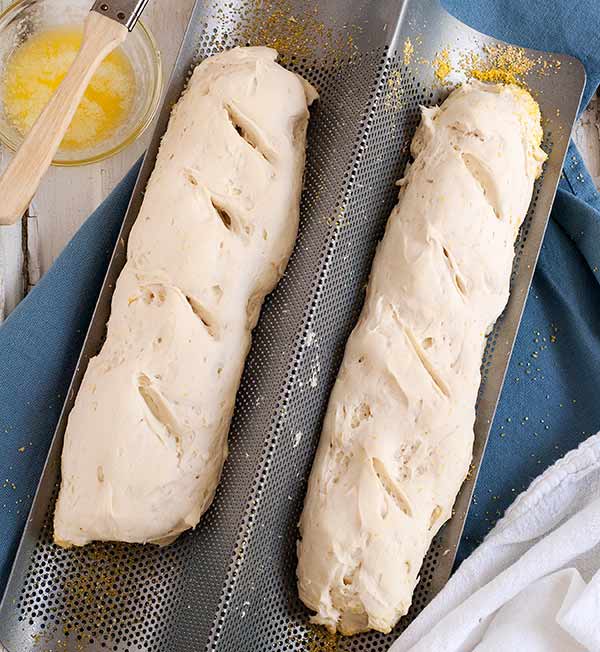


Gluten Free Easy, Easy, Easy! French Bread Recipe
Ingredients
- 2 tablespoons Dry Active Yeast
- 2 teaspoons sugar
- 1½ cups warm water, it should be pretty warm to the touch but not hot
- 3 teaspoons xanthan gum
- 2 tablespoons olive oil
- 1½ cups super fine or Asian white rice flour*
- ½ cup superfine or Asian sweet rice flour*
- 1 cup tapioca starch*
- 1½ teaspoons kosher or fine sea salt
- 2 large eggs, lightly beaten
- 1 teaspoon apple cider vinegar
- 2 teaspoons cornmeal, optional
- 2 tablespoons butter or Earth Balance, melted
Instructions
- Combine the yeast, sugar and warm water in a bowl about twice the size of the mixture and whisk to dissolve the sugar. Let sit for 5-6 minutes (10 if the yeast has been in the fridge) or until it is foamy and doubled in size.
- In a small bowl stir the xanthan gum with the olive oil until the xanthan gum is dissolved.
- Combine the flours, tapioca starch (or gluten free flour blend) and salt in the bowl of a mixer fitted with a whisk attachment (or just the regular beaters – don’t use a dough hook) and mix to combine. Add the yeast mixture, xanthan gum mixture, eggs and vinegar and mix on low to combine. Scrape down the sides of the bowl once. Turn the mixer to high and mix for 3 minutes.
- Spray a French bread pan (with 2 forms) with gluten-free, non-stick cooking spray or brush with more olive oil and sprinkle a teaspoon of cornmeal onto the bottom of each pan.
- Spoon the batter into the forms and shape into an oval with a spatula. Using a razor blade or sharp knife cut 3 or 4 diagonal slashes on top of each loaf. Cover the loaves with a clean kitchen towel and set in a warm, draft-free place to rise. Let rise for 30 minutes or until the loaves have doubled in size.
- Place a baking pan on the floor of your oven (or on the bottom shelf) and fill it with about an inch of really hot water. Position the rack you are baking the bread on in the middle of the oven. Turn the oven on and preheat to 400 degrees.
- Brush the top of the loaves with the melted butter or Earth Balance and bake for 40-45 minutes or until the loaves are golden brown and sound hollow when tapped. Let cool in the pan for 5 minutes then remove to a wire rack to finish cooling.
- You can also make crusty rolls by scooping the dough into 2 standard sized muffin tins, letting them rise 30 minutes and baking for about 20 minutes.
Notes
Nutrition
Nutrition information is automatically calculated, so should only be used as an approximation.
Shop This Post















This is a great recipe. I used 2 teaspoons of xanthan gum because I used a one to one flour mix. Mine were done in 30 min. I recommend cooking them to an internal temp. of 210. Best recipe out there for a gluten free french bread. Thank you!
I’m a gluten-eater, but my wife has celiac and so I’ve been intimately familiar with gluten-free cuisine (the good, the bad, and the gritty) for nearly 20 years. In all that time, I’ve tried all manner of gluten-free bread — all the while, gleefully indulging in the real deal whenever I’m away from home or otherwise able to do so.
And it is my informed, objective opinion that THIS BREAD IS AMAZING. It is easily THE BEST GF BREAD I’ve ever encountered — at home, in the store, or at any restaurant. But it holds its own against the real deal, too.
And that’s even after I goofed up the recipe quite a bit. I didn’t have Xanthum Gum on hand, and I used just King Arthur all-purpose flour instead of the recommended blend. Didn’t matter. The bread I made was crisp on the outside and fluffy, bubbly, chewy, and bouncy on the inside.
I made the bread in muffin tins (my french bread pan is now ordered and in the mail, thanks to this recipe) and experimented with different amounts of flour in every cup. The results were STUNNING.
The cup with the least flour was as runny as pancake batter, and the cup with the most was as dense and cracked as plaster — and I thought both of those, at least, were going to be epic failures. But the runny-batter yielded the fluffiest, lightest, and runaway favorite of my gluten-eating mother. And the dense-as-plaster cup (about double the amount of flour called for) resulted in, no joke, the BEST GF BISCUIT I’ve ever had. (And I don’t say that lightly. I’m a Southerner, and I was taught to bake biscuits by the best of the best of local, down-country talent — fluffy, light, divine things full of fat and gluten. This happy little accident wasn’t a perfect replacement for “the real deal” but it was darn close and downright tasty.) And everything in between was delicious, well-textured, chewy, bouncy, bread. BREAD PEOPLE. They all looked, smelled, felt, and chewed like real bread. The only proof these were gluten-free were the subtle taste differences between wheat and the other grains used in the flour blend, but even those differences were hard to discern over the perfect texture and delicious, buttery, yeasty overall flavor.
The fact that this recipe can modified with extremely different amounts of flour left me floored. First, it means that the recipe is really idiot-proof for those (like me) who are not the best at baking. But it also got me excited about all the other variants I can now try to make on purpose. Cakes, sandwich bread, biscuits, even pan-breads like naan — I’m excited to experiment some more.
HANDS DOWN THE BEST GLUTEN-FREE BAKING EXPERIENCE I’VE HAD IN TWO DECADES OF DISMAL DESPERATION.
Props to the chef.
WOW! Thank you so much, Robert. What a fantastic compliment! And I love that you were able to adapt the recipe into so many other things – how cool is that?! I’m very happy to hear that you had such a good experience with this recipe, as it’s one of my favorites, too. Keep me posted on what else you do with this recipe – I’d love to get some specifics from you so that other readers can try what you did.
With social distancing I’ve been experimenting with GF recipes as I am GF, DF & SF (last one is soy). My first try with this recipe was delicious but with a little “gummy” texture on the inside. Next time I’ll try your recommended lower temp and a longer bake time. Question…you say to use the whisk attachment on the mixer and most of my batter was stuck inside it after the three minutes of mixing. Should this have happened?
I tried this recipe yesterday. I was surprised to see it calls for 2 tablespoons of Dry Active Yeast. Most recipes I researched state 2 1/4 teaspoon, and I thought it was a typographical error. However, I followed the recipe, let it rise for 45 minutes (not the 30 as stated), and it did turn out a lovely golden brown colour, staying the size it had risen to before I put them in the oven. Unfortunately, I find it incredibly dense and heavy with very little elasticity and bounce, with hardly no air bubbles inside. I think I will try recipes with less yeast next time.
Just made this tonight and it was the bomb. I live at 6000 ft. altitude, so I upped the temp to 410… I also used a thermometer to check internal temp of bread…. I ended up having to bake it quite a bit longer to get it over 200 degrees, but it was worth it. The internal texture was amazing. I also used a flour that had xanthan gum in it already, so I only used 1/2 teaspoon of xanthan gum. The crust was thick and crunchy… I will probably try a lower temp next time to get a softer, less browned crust.
Thanks Lizze! Glad you like it. Appreciate the info about your tweaks for higher altitude.
I’m having such a hard time with this recipe and cannot figure out what I’m doing wrong :( I live at 1300ft above sea level so I don’t think altitude is an issue…. but I’ve tried this twice now and both times the batter is extremely runny… do you have any tips for this? I’m not sure where I’m messing up – it doesn’t look anything like what your batter does and literally won’t shape in the bread form its so runny. I’ve used all the same ingredients- I mixed for 3 minutes on high, maybe its too mixed? I know this will be difficult for you to trouble shoot I’m just baffled that I can’t get this right :'( Thank you so much for the recipe and I hope I can figure it out!
Hmmm… let’ see if we can figure this out. Did you make ANY ingredient swaps? Did you use the specified flours or one flour blend? If a flour blend, what brand or what ingredients are in it? Is your yeast fresh and not expired by chance?
I figured it out finally! My xanthan gum was outdated and once I got a new bottle the recipe worked perfectly- SO glad, it is delicious! Thank you so much for a wonderful recipe!
Great! I’m so glad you figured it out and that it turned out good!
Awesome post. Ziekenhuisleven